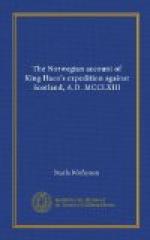After St Olave’s wake[50] King Haco, leaving Elidarwic, sailed south before the Mull[51] of Ronaldsha with all his navy. At this place King Haco was joined by Ronald from the Orkneys, with the ships that had followed him. King Haco next led the whole armament into Ronaldsvo, and lay there for some space. He then sent men over to Cathness[52] to levy contribution. He, on the one hand, proposed peace if the inhabitants would yield, but otherwise heavy punishment. The Cathnesians submitted to the tax, and King Haco appointed collectors to receive it, as is here intimated.
6.
First our wise Sovereign, the Bestower of peace, and Defender of the Northern Thrones, imposed tribute, the ransom of life, on the dwellers of the Ness.[53] All its tribes were terrified by the steel-clad exactor of rings,[54] and panic-struck at his mighty power.
While King Haco lay in Ronaldsvo a great darkness drew over the sun, so that only a little ring was bright round the sun, and it continued so for some hours.[55]
On the day of St Laurence’s wake[56] King Haco, having ordered the Orkney-men to follow him as soon as they were ready, sailed over Pentland-Firth,[57] Earl Magnus, however, staid behind. He was here informed that John Drotning,[58] and Kolbein Aslacson, with the ships expected from the east, but which had been accidentally detained, were arrived in the Islands. King Haco then sailed with all his forces to a haven that is called Asleifarvic,[59] from that to Lewes, so on to Raasa, and, from thence to that place, in Sky-sound, which is called Callach-stane.[60]
Here he was joined by Magnus King of Man, and the relations Erling Ivarson, Andrew Nicolson, and Halward. He next proceeded to the Sound of Mull,[61] and then to Kiararey where King Dugal and the other Hebridians were assembled with all their troops. King Haco had now above an hundred vessels, for the most part large, and all of them well provided both with men and arms.
While King Haco remained at Kiararey he divided his forces, and sent fifty ships south to the Mull of Kintire[62] to plunder. The captains appointed over them were King Dugal, Magnus King of Man, Bryniolf Johnson, Ronald Urka, Andrew Pott, Ogmund Kraekidants, Vigleic Priestson. He also ordered five ships for Bute; these were under the command of Erlend Red, Andrew Nicolson, Simon Stutt, Ivar Ungi Eyfari, and Gutthorm the Hebridian, each in his own ship.
King Haco sailed afterwards south to Gudey[63] before Kintire where he anchored. There King John met him; he came in the ship with Bishop Thorgil. King Haco desired him to follow his banner as he should do. But King John excused himself. He said he had sworn an oath to the Scottish King, and held of him more lands than of the Norwegian Monarch; he therefore entreated King Haco to dispose of all those estates which he had conferred upon him. King Haco kept him with him some time, and endeavoured to incline his mind to fidelity. Many laid imputations to his charge. King Haco indeed had before received bad accounts of him from the Hebrides; for John Langlife-son came to the King, while he was sailing west from Shetland, and told him the news that John King of the Hebrides, breaking his faith, had turned to the Scottish Monarch. King Haco, however, would not believe this till he had found it so.




